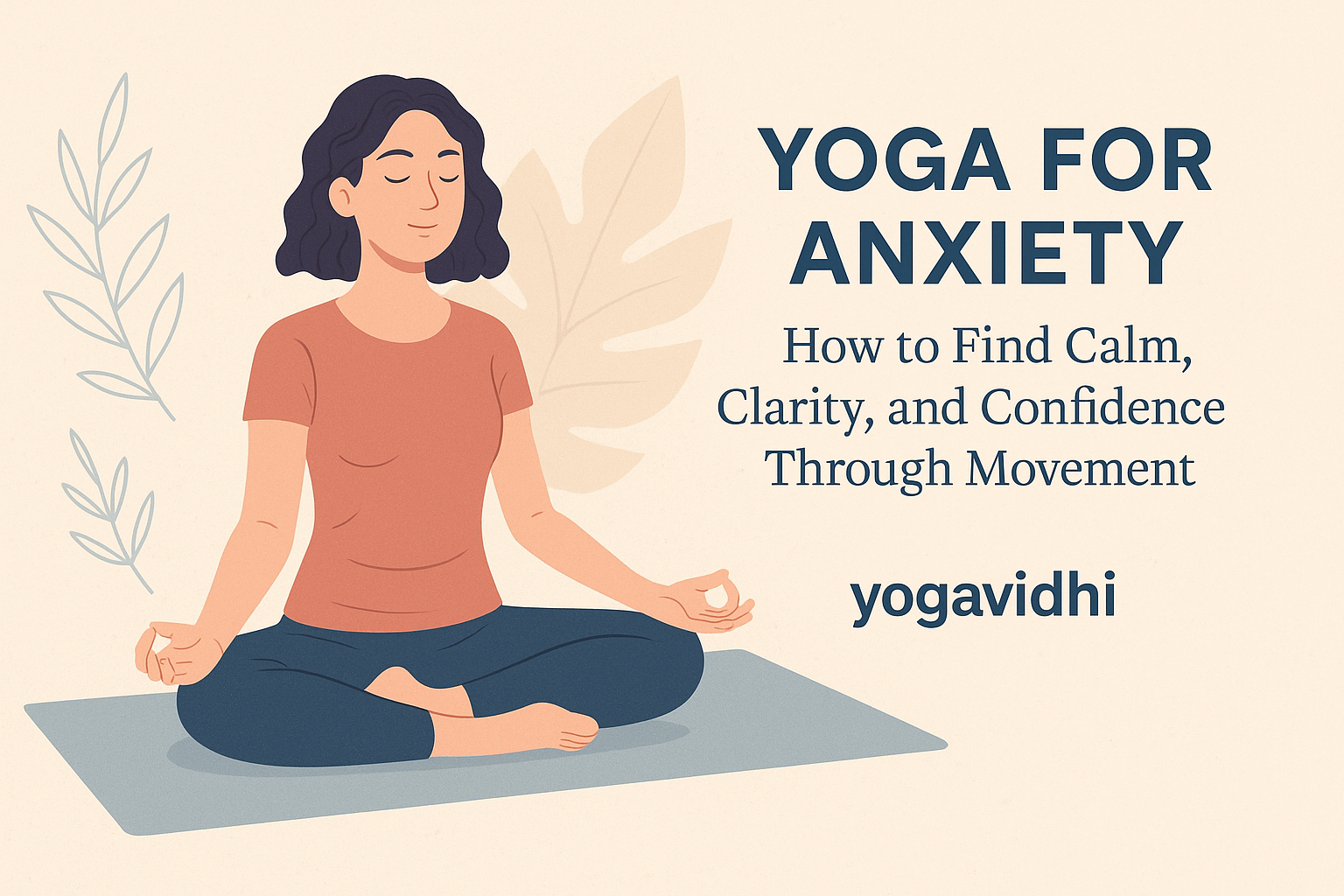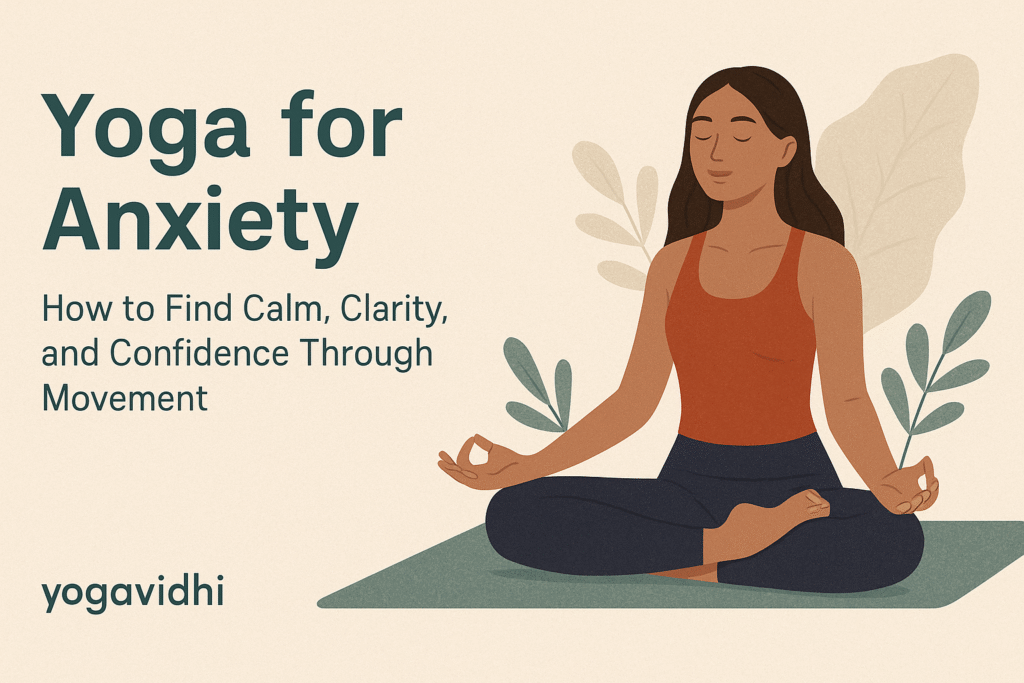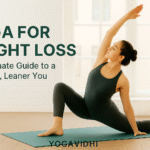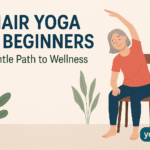In today’s fast-paced world, anxiety has become a silent epidemic. From deadlines and daily stressors to sleepless nights and social pressures, anxiety affects millions of people worldwide. While medication and therapy are valuable tools, many are now turning to a holistic and time-tested solution: yoga for anxiety.
Yoga isn’t just about flexibility or strength — it’s about grounding yourself, connecting with your breath, and quieting the noise in your mind. In this guide, we’ll explore how yoga can help relieve anxiety, the best poses and practices to get started, and how to create a calming yoga routine at home.
Yoga, through targeted poses and breathing techniques, offers an effective way to manage anxiety by stimulating the parasympathetic nervous system, encouraging relaxation, and easing the physical signs of stress. Helpful postures include Child’s Pose, Cat-Cow, Tree Pose, and Bridge Pose. Breathing practices such as Nadi Shodhan and Bhramari are also known to soothe the mind and alleviate anxiety.
Table of Contents
Understanding Anxiety: A Modern-Day Challenge
Before we dive into the benefits of yoga for anxiety, let’s take a moment to understand what anxiety really is.
Anxiety is your body’s natural response to stress — a state of heightened alertness designed to protect you from danger. However, when anxiety becomes chronic, it can take a toll on both your physical and emotional well-being.
Common Symptoms of Anxiety:
- Racing thoughts
- Shortness of breath
- Chest tightness
- Sleep disturbances
- Constant worry or fear
- Irritability or restlessness
Millions seek relief through medication, but what if you could find peace through your breath and body? That’s where yoga for anxiety relief enters the picture.
How Yoga Helps with Anxiety
Yoga is more than just exercise — it’s a mind-body practice that has been shown to lower cortisol levels, calm the nervous system, and reduce stress. Whether you’re a complete beginner or a seasoned yogi, yoga provides a gentle, accessible, and highly effective way to manage anxiety.
Key Benefits of Yoga for Anxiety:
- Activates the parasympathetic nervous system (your body’s “rest and digest” mode)
- Reduces cortisol (the stress hormone)
- Enhances mindfulness and emotional regulation
- Encourages deeper, more conscious breathing
- Improves sleep and overall mental health
Studies from institutions like Harvard Medical School have confirmed that consistent yoga practice reduces symptoms of anxiety and depression. It’s not a quick fix — but with time, yoga can help rewire your brain’s response to stress.
The Best Yoga Poses for Anxiety Relief
Not all yoga is created equal when it comes to anxiety. To calm the mind and relax the body, focus on slow, grounding postures that emphasize breath and stillness.
1. Child’s Pose (Balasana)
This gentle forward bend helps release tension in the back, neck, and shoulders while grounding the mind.
How to Practice: Kneel on your mat, fold forward, and rest your forehead on the ground. Breathe deeply and hold for 1-2 minutes.
2. Legs-Up-The-Wall Pose (Viparita Karani)
Anxiety often leads to a racing heart. This pose promotes circulation, calms the nervous system, and eases fatigue.
How to Practice: Lie on your back and swing your legs up against a wall. Place a cushion under your hips for added comfort. Stay for 5–10 minutes.
3. Cat-Cow Stretch (Marjaryasana-Bitilasana)
This gentle movement soothes the spine and helps link breath to motion — a vital component of yoga for anxiety relief.
How to Practice: Start on your hands and knees, alternate between arching and rounding your back with your breath.
4. Seated Forward Fold (Paschimottanasana)
A deep, calming stretch for the back of the body, this pose also encourages introspection and calm.
How to Practice: Sit tall with legs extended, then fold forward over your legs. Use a strap or pillow if needed.
5. Corpse Pose (Savasana)
Though it looks simple, this is one of the most powerful poses to calm the mind and integrate your practice.
How to Practice: Lie flat on your back, arms by your sides, eyes closed. Focus on your breath and let your body fully relax.
Read More: Yoga for Weight Loss: The Ultimate Guide to a Healthier, Leaner You
Read More: Yoga Postures: The Ultimate Guide to Poses for Strength, Flexibility & Balance
Pranayama: Breathing Techniques to Ease Anxiety
Breathwork (pranayama) is a central pillar of yoga for anxiety. When we control our breath, we calm our mind and regulate our nervous system.
Try These Breathing Techniques:
- Alternate Nostril Breathing (Nadi Shodhana): Balances the left and right brain; great before bed or during panic.
- Ocean Breath (Ujjayi): Creates a soothing sound like waves, helping you stay centered during practice.
- Box Breathing: Inhale for 4 counts, hold for 4, exhale for 4, hold for 4. Repeat for several minutes.
Just five minutes of mindful breathing each day can have a profound effect on your mood and anxiety levels.
Best Yoga Styles for Anxiety Relief
When selecting a style of yoga for anxiety, look for gentle, slow-paced classes that emphasize stillness and breath.
Recommended Yoga Styles:
- Yin Yoga: Long-held postures that target deep connective tissues and promote stillness.
- Restorative Yoga: Uses props to support the body and allow complete relaxation.
- Hatha Yoga: A slower pace that focuses on alignment, breath, and mindfulness.
- Yoga Nidra (Yogic Sleep): A guided meditation that brings you into a deep, restful state — ideal for anxiety and insomnia.
Many online platforms and apps now offer beginner-friendly yoga for anxiety classes that you can do anytime, anywhere.
Building a Daily Yoga Routine for Anxiety
You don’t need a 90-minute class or a fancy studio to benefit from yoga. Just 15–30 minutes a day can make a huge difference.
Sample Weekly Yoga for Anxiety Plan:
| Day | Focus | Practice Time |
| Monday | Gentle Flow + Breath | 20 min |
| Tuesday | Yin Yoga | 30 min |
| Wednesday | Breathing + Meditation | 15 min |
| Thursday | Hatha Yoga | 30 min |
| Friday | Restorative Yoga | 20 min |
| Saturday | Yoga Nidra | 25 min |
| Sunday | Nature Walk + Breath | – |
Consistency is key. Even 10 minutes a day is more effective than a single long session each week.
Lifestyle Tips to Support Your Anxiety Journey
Yoga is powerful, but it works best when paired with other healthy habits:
- Practice daily gratitude journaling
- Limit screen time, especially before bed
- Prioritize sleep hygiene
- Fuel your body with nutritious foods
- Stay hydrated and avoid excess caffeine
- Build a supportive community or connect with a therapist
Yoga for anxiety is a lifestyle, not just a workout.

Real Stories: How Yoga Changed Lives
“Yoga helped me breathe again. After years of living with anxiety attacks, I started with five-minute yoga videos. Slowly, my body softened, and my mind stopped racing.”
— Priya S., 34
“I used to wake up with panic. Now, I start every morning with a few minutes of child’s pose and alternate nostril breathing. It’s my anchor.”
— Ravi M., 42
These aren’t just testimonials — they’re proof that with small, consistent steps, yoga can transform your inner world.
Final Thoughts: Let Yoga Be Your Safe Space
If anxiety has you feeling overwhelmed, yoga can be your safe haven. It invites you to come back to yourself — one breath, one pose, one moment at a time.
Whether you’re rolling out your mat for the first time or rediscovering your practice, remember: You are not alone. The calm you seek is already within you.
Start small. Breathe deeply. Move gently. And let the healing power of yoga for anxiety guide you home.
FAQ:
Q. Can yoga completely cure anxiety?
Ans: Yoga is not a cure but a powerful tool for managing symptoms and building resilience. It works best alongside other self-care and professional support.
Q. How soon will I see results?
Ans: Many feel calmer after just one session, but long-term change happens with consistent practice over weeks or months.
Q. Do I need to be flexible to do yoga for anxiety?
Ans: Not at all! Yoga for anxiety is gentle, accessible, and beginner-friendly. It’s about breath and awareness, not bending like a pretzel.
Q. What is the best time of day to practice yoga for anxiety?
Ans: The best time to practice yoga for anxiety is whenever you can consistently fit it into your day. However, many people find early morning or evening particularly effective — mornings help set a calm tone for the day, while evenings help release built-up tension and prepare you for restful sleep.
Q. Can I practice yoga for anxiety at home without a teacher?
Ans: Absolutely. You can safely practice yoga for anxiety at home using online videos, mobile apps, or written guides. Start with gentle poses and breathing techniques. As you grow more comfortable, you can expand your routine. Just ensure you listen to your body and move at your own pace.
Q. What yoga is best for anxiety?
Ans: Some days, slower styles like Hatha or gentle forms such as restorative or Yin yoga may be just what you need to calm your mind, as they help activate the body’s relaxation response. On other days, more dynamic practices like Vinyasa can be equally beneficial.
Q. What is the 3 3 3 rule for anxiety?
Ans: The 333 rule for anxiety is a simple and effective technique to use when something triggers your anxiety. It involves identifying three objects you see, three sounds you hear, and then moving three parts of your body.
Q. How to calm down anxiety naturally?
Ans: Ways to Cope with Anxiety, Fear, and Panic:
1. Share your feelings with someone you trust, like a friend, family member, counselor, or healthcare professional.
2. Practice calming breathing techniques.
3. Stay active – activities like walking, running, swimming, or yoga can help you feel more relaxed.
Q. How did I finally beat my anxiety?
Ans: Helpful strategies for managing anxiety include journaling, grounding exercises, physical activity, and meditation. These techniques can assist in reducing and controlling anxiety symptoms. Stress is the body’s natural reaction to a real or perceived threat.
Declaration Note:
We use third-party videos and images on https://yogavidhi.com/ for educational and illustrative purposes. All rights belong to their respective owners. No copyright infringement is intended.



